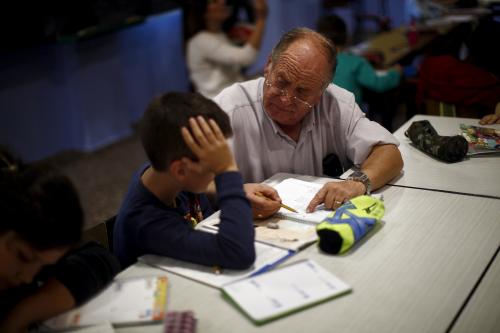Like it or not, we’re a country of consumers. We buy an amazing quantity of goods and services—everything from iPhones and hamburgers to emerald grass and expensive vacations. Big companies like Coca-Cola and Netflix spend billions of dollars on marketing and advertising to drive this consumption, the brands that are the best at it aren’t just artists and storytellers; they’re applying voluminous marketing research on how to most effectively communicate with consumers. By leveraging insights the private sector has gleaned over decades of experimentation, educators can support their students to access valuable programs and opportunities they might not have otherwise known about or understood.
Ask professional educators in any school system and they’ll tell you that they’re in a very different line of work from big consumer brands. Their goal is not to sell goods or services, but to catalyze learning and personal growth for their students. Schools measure their impact in terms of academic performance and future educational trajectories, not profit margins. What schools and brands have in common, however, is the need to effectively communicate with and catalyze key constituents.
While improving communication can seem like a comparatively trivial issue for schools, the costs of ineffective communication can actually be rather profound. For example, in communities with robust school choice programs, parents and children can only find their way to high-quality schools to the extent they know schools vary in quality, and which may have open seats. Yet even the most important school communications tend to receive little investment or attention; letters and emails are often dense, text-heavy, and have minimal, if any, visual design. And while an increasing number of schools have incorporated social media into their outreach efforts, posts tend to be static and bland.
The private sector, of course, views every communication touch point as an opportunity to build audience engagement and rapport. Apple consumers want smart phones and tablets, but they’re also drawn to a brand that’s intelligent and cutting-edge. Communication is crucial to for-profit brand strategies, and accordingly receives tremendous investment and focus.
While schools don’t have the budget that private companies can devote to their advertising efforts, they can still substantially improve communication with students and families. Big brands prioritize several key principles schools can learn from and adopt:
- Communicate in the medium most used by the audience.
- Communicate in amounts and through layouts the audience is willing to ingest.
- Use language the audience will understand.
- Include a call to action the audience can answer.
- Provide a clear result the audience both desires and is capable of achieving if they follow through on the call to action.
As teachers, students, and families jump headfirst into another school year, we recommend school leaders take several concrete steps to strengthen their communication with students and families:
Conduct an audit of your current communications efforts.
School leaders should start with a critical review of communications materials used in the last academic year. Questions to ask about these materials:
- Where could we simplify content? We tend to overestimate readers’ capacity to accept written information, both analog and digital. A single sheet of information that’s densely packed is daunting to the eye, and can sometimes discourage the audience from even beginning to read the item. Simple fixes for lengthy communications include tactics like cutting copy, calling out important points through visual hierarchy, increasing white space, and including sources for further information if the consumer is interested rather than including it all up front. Even for educational institutions, content should follow journalism rules for vocabulary and comprehension at a simple level. Several districts have found, for instance, that simplifying information about school choice can lead students to attend higher-quality schools where they perform better.
- Where could we be more visual? Communications are becoming increasingly visual in our society, in response to shorter attention spans and shifts in young people’s preference for apps like Snapchat and Instagram, which require visuals to post. We can potentially get much further with students and families through well-designed images and infographics than through text-centered communications.
- How could I use more effective channels? Print materials risk not making the journey home; emails are often buried in an inbox full of spam and unopened messages. Researchers and educators are currently having substantial success with texting students and families about everything from parents reading with their child to students completing required college tasks, but texting is also becoming increasingly saturated as a channel. Schools should strive to stay relevant and current in the channels through which they communicate, in order to meet students where they are.
Identify critical junctures where improvements to communication are most important
Given the sheer volume of communication schools send every year, it’s probably not feasible to do a complete overhaul of all communications during the back-to-school season. We encourage school leaders to focus first on revising communications around particularly important decisions students and families face, like which schools to attend, which courses to take, and whether to apply for benefits or programs, like financial aid for college. These decisions often require students to digest complex information and weigh multiple options in a limited timeframe. Well-designed communications around these critical junctures can help students and families make active and informed choices about the pathways they pursue.
Test what works
This is perhaps one of the most important insights to glean from how the private sector approaches communication: test variations and see if they lead to more positive behavior change among students and families. Many digital communications platforms, like Mailchimp and Hootsuite, now come with built-in analytics packages, which provide school leaders with ready access to data on how audiences respond to different strategic communications. Another important component of testing is to prototype materials with the target audience. Put new designs in front of students and parents and ask thoughtful questions about the effectiveness of the pieces.
The core business of schools is to educate, but education requires that we effectively engage key constituents. Strengthening our communications strategies in schools is a low-cost strategy to boost engagement and generate improved outcomes for students.
Coca-Cola is a donor to the Brookings Institution. The findings, interpretations, and conclusions posted in this piece are solely those of the authors and not influenced by any donation.






Commentary
Learn to Ad: Madison Avenue strategies to strengthen school communication
September 6, 2016